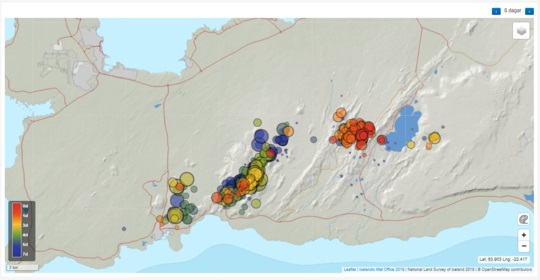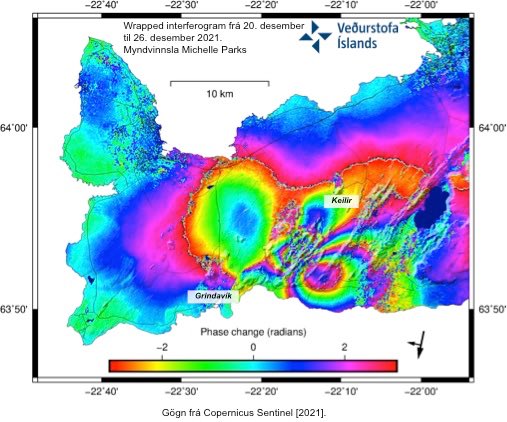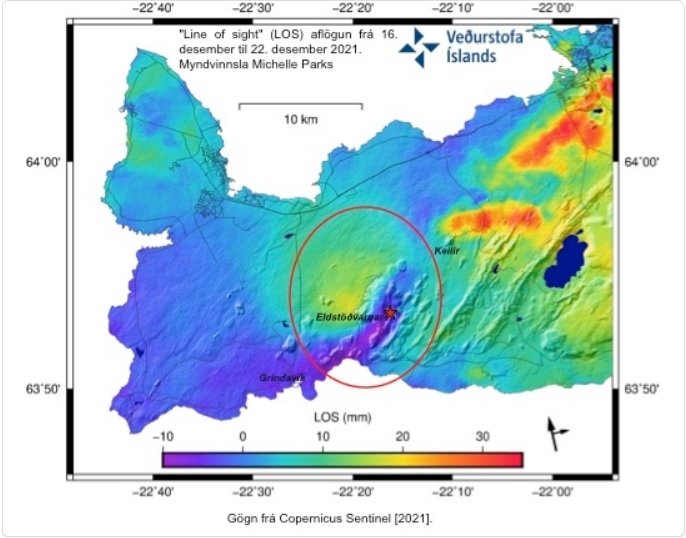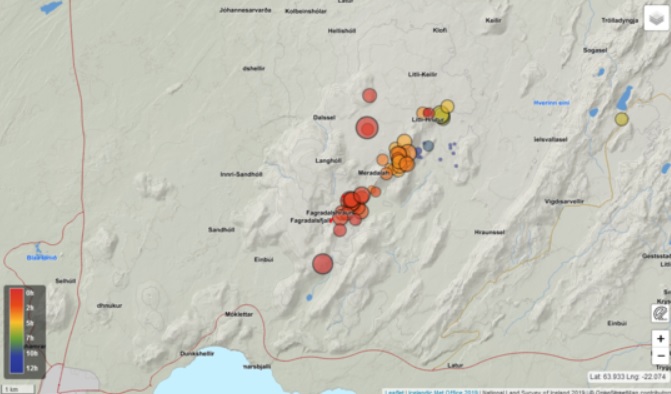Luca Caruso-Moro
CTVNewsMontreal.ca Digital Reporter
Tuesday, December 28, 2021

A seismograph reading from the Institute of Ocean Sciences in Sidney on Monday is pictured: Dec. 23, 2019 (CTV News)
Some Quebecers felt the ground, windows and walls around them shake Tuesday night as a magnitude 4.1 earthquake rumbled an area near Val d'Or.
The quake took place about 40 kilometres northwest of the city, or nearly 600 kilometres northwest of Montreal.
It hit at around 6:22 pm and was located 10 kilometres below the surface of the earth, according to Earthquake Canada.
Magnitude 4.1 quakes are considered mild on the intensity scale. It remains unclear whether any significant damage was caused.

A magnitude 4.1 earthquake struck near Val D’Or Tuesday evening. (Image source: Earthquakes Canada)
At the local depanneur in the town of Malartic, the wine bottles on the shelves began to shake, the cashier on duty told CTV News.
"The bottles on the shelves were shaking," she said. "It was pretty strange. I’ve never seen that before."
Many other locals also reported online that they felt the shaking. Some, in the mining-heavy region, first believed they were feeling the effects of blasting at a nearby mine.
Tuesday, December 28, 2021

A seismograph reading from the Institute of Ocean Sciences in Sidney on Monday is pictured: Dec. 23, 2019 (CTV News)
Some Quebecers felt the ground, windows and walls around them shake Tuesday night as a magnitude 4.1 earthquake rumbled an area near Val d'Or.
The quake took place about 40 kilometres northwest of the city, or nearly 600 kilometres northwest of Montreal.
It hit at around 6:22 pm and was located 10 kilometres below the surface of the earth, according to Earthquake Canada.
Magnitude 4.1 quakes are considered mild on the intensity scale. It remains unclear whether any significant damage was caused.

A magnitude 4.1 earthquake struck near Val D’Or Tuesday evening. (Image source: Earthquakes Canada)
At the local depanneur in the town of Malartic, the wine bottles on the shelves began to shake, the cashier on duty told CTV News.
"The bottles on the shelves were shaking," she said. "It was pretty strange. I’ve never seen that before."
Many other locals also reported online that they felt the shaking. Some, in the mining-heavy region, first believed they were feeling the effects of blasting at a nearby mine.
ICELAND
Fagradalsfjall volcano update: more and
more frequent earthquakes reflect magma
intrusion
Wed, 29 Dec 2021, 04:30
04:30 AM | BY: MARTIN
The seismic activity during 21-28 Dec on the Reykjanes peninsula (image: IMO)
A maximum magnitude of 3.6 occurred yesterday at 08:25 local time.
Magma migration at depth is still about to pressurize and the increase in the seismic activity is likely a sign of its accumulation.
19000 earthquakes have already been detected in total, mostly with magnitudes of 4 or more since the seismic crisis started on 21 December.
- All news about: Fagradalsfjall volcano
- Information about: Fagradalsfjall volcano
Tue, 28 Dec 2021, 00:28
The number of earthquakes rapidly increasing but the activity slowed down a bit over the past 24 hours. ... Read all
Sun, 26 Dec 2021, 21:54
The seismicity continues at increasing levels. ... Read all
How Fault Surface Features Can Tell Us About Future Earthquakes
A new study suggests ways to quantify fault maturity, a property that affects earthquake characteristics.
21 December 2021

Citation: Thompson, E. (2021), How fault surface features can tell us about future earthquakes, Eos, 102, https://doi.org/10.1029/2021EO210677. Published on 21 December 2021.
Text © 2021. The authors. CC BY-NC-ND 3.0

The San Andreas Fault, a mature strike-slip fault, is well studied because it lies near major population centers. Understanding fault maturity here and at other faults can help scientists model earthquakes and assess risks to nearby communities. Credit: Doc Searls, CC BY-SA 2.0
Source: Geophysical Research Letters
Earthquakes cannot be forecast like weather, but fault line characteristics, such as structural maturity, can give hints about how a future earthquake may act. Structural maturity is related to the age of the fault, but especially important is its “experience,” how much a fault has developed and changed over time and activity.
Mature and immature faults generate very different earthquakes. Mature faults release less stress, but their rupture propagates quickly down their length, whereas immature faults create high-energy, slower quakes. A quick assessment of a fault’s maturity will help scientists better understand the risks they pose to nearby communities.
A new study seeks to quantify faults’ maturity into a useful metric to help assess earthquake risks. Manighetti et al. measured surface features of fault lines that previous studies had evaluated at several maturity levels. They then analyzed their measurements to see how they related to the maturity judgment.
The researchers found that corrugation (i.e., undulation) and step-overs were good maturity indicators. Immature faults were reliably shorter, with high corrugation and high step-over density. As faults matured, they lengthened and smoothed out, reducing undulations and step-over density.
These traits are not only reliable across faults; they are also detectable at low resolutions. Scientists can map as little as a third of a fault’s length at relatively low resolution and still generate an accurate assessment of a fault’s maturity. This means that these metrics are practical for models and hazard assessments. Applying neural networks to the mapping process would make this method even easier, according to the authors. (Geophysical Research Letters, https://doi.org/10.1029/2021GL095372, 2021)
—Elizabeth Thompson, Science Writer
Source: Geophysical Research Letters
Earthquakes cannot be forecast like weather, but fault line characteristics, such as structural maturity, can give hints about how a future earthquake may act. Structural maturity is related to the age of the fault, but especially important is its “experience,” how much a fault has developed and changed over time and activity.
Mature and immature faults generate very different earthquakes. Mature faults release less stress, but their rupture propagates quickly down their length, whereas immature faults create high-energy, slower quakes. A quick assessment of a fault’s maturity will help scientists better understand the risks they pose to nearby communities.
A new study seeks to quantify faults’ maturity into a useful metric to help assess earthquake risks. Manighetti et al. measured surface features of fault lines that previous studies had evaluated at several maturity levels. They then analyzed their measurements to see how they related to the maturity judgment.
The researchers found that corrugation (i.e., undulation) and step-overs were good maturity indicators. Immature faults were reliably shorter, with high corrugation and high step-over density. As faults matured, they lengthened and smoothed out, reducing undulations and step-over density.
These traits are not only reliable across faults; they are also detectable at low resolutions. Scientists can map as little as a third of a fault’s length at relatively low resolution and still generate an accurate assessment of a fault’s maturity. This means that these metrics are practical for models and hazard assessments. Applying neural networks to the mapping process would make this method even easier, according to the authors. (Geophysical Research Letters, https://doi.org/10.1029/2021GL095372, 2021)
—Elizabeth Thompson, Science Writer
Citation: Thompson, E. (2021), How fault surface features can tell us about future earthquakes, Eos, 102, https://doi.org/10.1029/2021EO210677. Published on 21 December 2021.
Text © 2021. The authors. CC BY-NC-ND 3.0




No comments:
Post a Comment